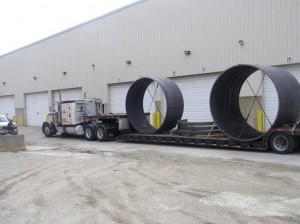With the increased use of curved steel members in construction and equipment, questions arise as to how to ship large steel loads.
The maximum sizes for non-permitted loads (those where special trucking permits are not required) are as follows: 52′ long (624″); 8′ 6″ wide (102″) and 13′ 6″ high. Curved steel members are often at least this large.
Any single dimension or combination thereof requires permits and/or special equipment. The larger the dimension is beyond those listed, the stricter the requirements for shipping which vary from state to state. Overdimensional loads cannot be “built;” the size of the load is determined by the largest single piece.
53′ to 60′ requires permits.
60′ to 70′ requires permits plus an escort vehicle. Escort-vehicle requirements differ from state to state.
8′ 7″ wide to 11′ 11″ wide requires permits.
12′ wide to 13′ wide requires permits plus an escort vehicle.
All oversize loads also have special routing (restricted streets, highways and toll roads). And the special routing varies from–and is determined by–municipalities and states. Oversize loads cannot travel after dark or on weekends or on holidays. In certains cities like Chicago, they cannot travel during certain times during the day.
Oversize loads are more expensive to ship than legal non-permitted loads. The rate per mile is higher, and there is a permit cost for each state through which the load travels. Usually the cost is 25% to 30% higher per mile for permitted load vs. non-permitted loads plus permits and escort vehicles when necessary. The cost of a pilot car (escort service) can cost up to 50% to 60% of the price for the truck moving the freight. This does not make the transportation cost prohibitive, however, because the value of the larger freight merits the extra expense.








